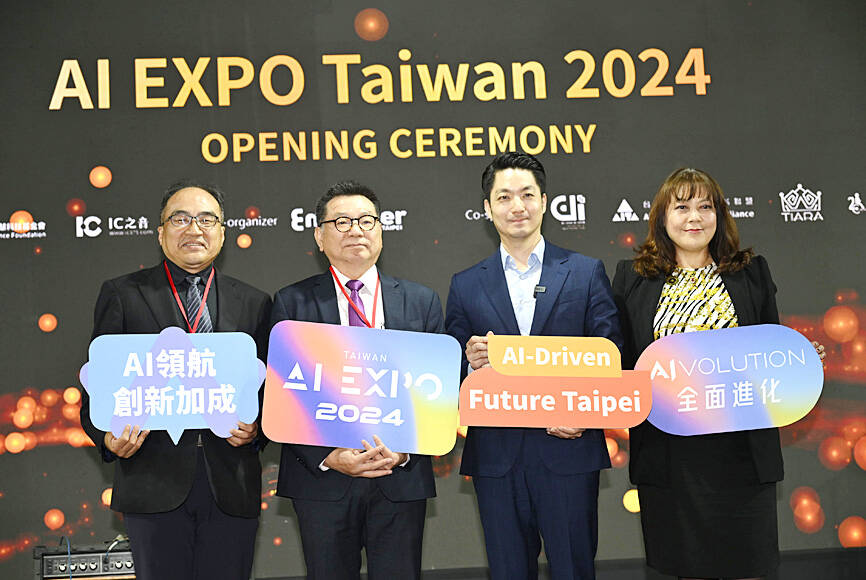The potential of generative artificial intelligence (AI) is “infinite” and it is therefore hard to estimate what its market value could rise to, evidenced by the huge range of predictions — US$200 billion to US$7 trillion — made by various institutions, Qualcomm Technologies Inc vice president S.T. Liew (劉思泰) said at an AI event in Taipei yesterday.
Liew, who is also president of Qualcomm’s business in Taiwan and Southeast Asia, told a keynote speech at the AI Expo Taiwan that the world has embarked on a journey to be at one with “AI everywhere.”
That means more processing power will be required and applications of all kinds from cloud services to edge AI will be developed, he said.

Photo: Chang Chia-ming, Taipei Times
“Statista Market estimated the value of the generative AI market will rise to US$207 billion in 2030, Bloomberg Intelligence said US$1.3 trillion by 2032, and McKinsey & Co forecasted that it could eventually be worth up to US$7.9 trillion,” Liew said.
“But these are just business scales; if you take into account all the direct and indirect productivity improvement and consumer satisfaction improvement, even US$7.9 trillion is considered low,” he said.
Generative AI refers to a type of AI that can create new content and ideas, for example, stories, videos and music.
With 5G connectivity in place, AI will not only be “connected everywhere,” but that connectivity will also be “intelligent” and will be able to be used for daily tasks such as “the car calculating the fastest route to my office with a stop to buy a cup of coffee,” Liew said.
These are the edge AI or “on-device AI” applications, he noted, which ABI Research, a global advisory firm providing strategic analyses on technology, forecast could overtake cloud AI services by revenue in 2028.
“There will be billions of devices in the world equipped with AI, so you can imagine the business opportunities for companies of all sizes. This is in contrast to cloud services which are dominated by a few tech giants,” Liew said.
On-device intelligence has also the benefit of reducing costs and energy as the cost and power of transmitting data to the cloud is saved, he said.
“Devices can also be personalized without risk of a privacy leak because a cloud service is not being used,” he added.
The Qualcomm executive said the company has a mission to build an “ecosystem” around Generative AI with shared tools and resources to increase the opportunities for all partners to innovate and make new products.
The AI expo opened yesterday and runs until tomorrow at Taipei Expo Park.

TAKING STOCK: A Taiwanese cookware firm in Vietnam urged customers to assess inventory or place orders early so shipments can reach the US while tariffs are paused Taiwanese businesses in Vietnam are exploring alternatives after the White House imposed a 46 percent import duty on Vietnamese goods, following US President Donald Trump’s announcement of “reciprocal” tariffs on the US’ trading partners. Lo Shih-liang (羅世良), chairman of Brico Industry Co (裕茂工業), a Taiwanese company that manufactures cast iron cookware and stove components in Vietnam, said that more than 40 percent of his business was tied to the US market, describing the constant US policy shifts as an emotional roller coaster. “I work during the day and stay up all night watching the news. I’ve been following US news until 3am

UNCERTAINTY: Innolux activated a stringent supply chain management mechanism, as it did during the COVID-19 pandemic, to ensure optimal inventory levels for customers Flat-panel display makers AUO Corp (友達) and Innolux Corp (群創) yesterday said that about 12 to 20 percent of their display business is at risk of potential US tariffs and that they would relocate production or shipment destinations to mitigate the levies’ effects. US tariffs would have a direct impact of US$200 million on AUO’s revenue, company chairman Paul Peng (彭雙浪) told reporters on the sidelines of the Touch Taiwan trade show in Taipei yesterday. That would make up about 12 percent of the company’s overall revenue. To cope with the tariff uncertainty, AUO plans to allocate its production to manufacturing facilities in

Six years ago, LVMH’s billionaire CEO Bernard Arnault and US President Donald Trump cut the blue ribbon on a factory in rural Texas that would make designer handbags for Louis Vuitton, one of the world’s best-known luxury brands. However, since the high-profile opening, the factory has faced a host of problems limiting production, 11 former Louis Vuitton employees said. The site has consistently ranked among the worst-performing for Louis Vuitton globally, “significantly” underperforming other facilities, said three former Louis Vuitton workers and a senior industry source, who cited internal rankings shared with staff. The plant’s problems — which have not

COLLABORATION: Given Taiwan’s key position in global supply chains, the US firm is discussing strategies with local partners and clients to deal with global uncertainties Advanced Micro Devices Inc (AMD) yesterday said it is meeting with local ecosystem partners, including Taiwan Semiconductor Manufacturing Co (TSMC, 台積電), to discuss strategies, including long-term manufacturing, to navigate uncertainties such as US tariffs, as Taiwan occupies an important position in global supply chains. AMD chief executive officer Lisa Su (蘇姿丰) told reporters that Taiwan is an important part of the chip designer’s ecosystem and she is discussing with partners and customers in Taiwan to forge strong collaborations on different areas during this critical period. AMD has just become the first artificial-intelligence (AI) server chip customer of TSMC to utilize its advanced